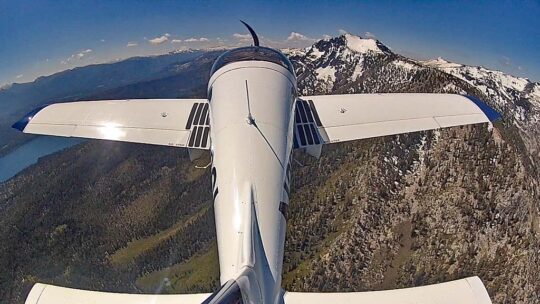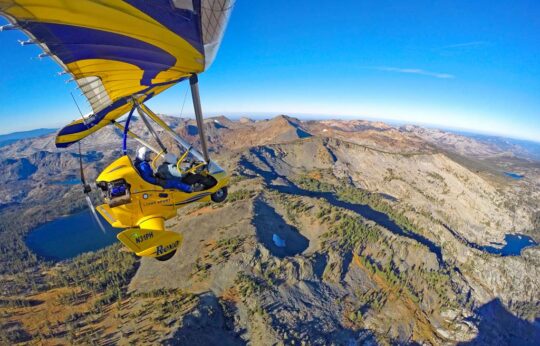Normally, this website focuses tightly on airplanes and the equipment and services needed to keep them flying. However, on regular occasions, I receive questions about density altitude and light aircraft. A surprising number believe LSA perform less well than legacy airplanes in these conditions. (They’re wrong.)
 Since I also hear questions regarding techniques to fly in mountains, why not combine these two challenges? This information can be useful to anyone who flies any kind of aircraft anywhere in the world.
Since I also hear questions regarding techniques to fly in mountains, why not combine these two challenges? This information can be useful to anyone who flies any kind of aircraft anywhere in the world.
To provide the best information, I went to an expert. I know a thing or two about airplanes but Paul Hamilton, founder of the Sport Aviation Center, is an expert trainer, not only writing and making videos on the subject for years but regularly providing flight instruction. Further demonstrating his versatility he does so in three-axis and weight shift.
I asked Paul to compose a short lesson about density altitude and he quickly complied. —DJ

Hot days at high elevations with a full load means you need much more runway.
It was a hot day (80 degrees Fahrenheit) at Lake Tahoe Airport (6,268 feet MSL). The airplane was loaded with a big guy (who reported 250 pounds) and nearly full fuel. We had a light tailwind because the airport has rising terrain to the south and we needed to take off to the north over flat terrain towards the lake.
Applying full throttle, we began moving down the runway …rolling, rolling, rolling. It felt like eternity to accelerate and finally lift off and we were going way faster over the ground while climbing sluggishly over the marshland to the lake.
Three of the basic performance problems which have led many General Aviation aircraft accidents were present here:
- High density altitude
- Max gross weight
- Tailwind

Mountains and high density altitude demand your attention.
The LSA we were using performed great, but revealed a big difference in performance compared to sea level flying. Let’s break this down into the components and look at why this Nevada attempt took so long to take off.
FAA’s definition for density altitude:
- “Pressure altitude corrected for temperature and humidity.”
- Common sense definition – “less air” (density) resulting in reduced engine power plus faster takeoff, stall and landing speeds — because true air speed goes up.
Starting with the FAA definition, pressure altitude is found by setting the altimeter to 29.92 inches of mercury (standard pressure) and reading the resulting “pressure altitude” on the altimeter. Low barometric pressure, less air above you, results in higher (less dense) pressure altitude. High barometric pressure, more air above you, results in a lower (more dense) pressure altitude.

Pressure Altitude Chart
From the well-known FAA diagram (pressure altitude) we can see that with higher barometric pressure you could lower your pressure altitude by by up to 1,000 feet or so, from 6,500 to 5,500. Falling pressure raises your density altitude by up to 2,000 feet 6,500 to 8,500. Typically, it would be less but for calculation expect atmospheric pressure could raise or lower your standard temperature altitude by 500 feet.
Now let’s look at temperature. Standard temperature for 6,500 altitude is about 37 degrees F. If we have a hot day say 80 degrees F, the pressure altitude is 6,500 feet, but density altitude goes up to 9,500 feet. Note that variations in temperature can cause the density altitude to go up 3,500 feet altitude and pressure altitude only 500 feet variation. Temperature makes a much bigger difference in density altitude.
You can use any app, the classic E6B computer, or an electronic E6B to find density altitude. You can also listen to the AWOS; you have various ways to determine density altitude.
Now, how does density altitude affect performance? Let’s start with the rule of thumb I teach and use as a basic for density altitude performance. Take this with you.
At 8,000 feet density altitude, it takes about twice as long to lift off as it does from sea level.
This is derived from various performance parameters, and it could be 7,000 foot density altitude but 8,000 feet is a good round number for this rule of thumb.

Temperature and Density Altitude Chart
Why is this?
First, for every 1,000 feet increase in density altitude, the engine loses about 3% power or thrust. So at 8,000 feet density the 100 horse engine is only producing 76% of the thrust, a 24% loss of thrust.
Second, if you rotate at 60 knots indicated airspeed at sea level, then at 8,000 foot density altitude your true airspeed (ground speed in calm air), rotation speed would be 68 knots. Keep in mind your visual reference to the ground speed for takeoff and landing is going to go up 13%. This is why people tend to stall during takeoff and landing, because they feel they are going faster than they normally do. Indicated airspeed, not true airspeed, is what counts in stall.
Therefore, at 8,000 foot density altitude you have 24% less thrust and must get going 13% faster to rotate. All that weight and mass has to gain that much more momentum with significantly less engine power. Loose/loose or bad/bad situation.
Now look at climb rate, your ability to get away from the earth. A 1,000 foot density altitude decreases climb rate by 8%. An 8,000 foot density altitude reduces climb rate by over 60%.

Let’s go back to my original example and use the rule of thumb with the density altitude of 9,500 feet MSL, plus that tail wind of 10%. Takeoff speed will increase takeoff roll by 20% to the density altitude factor. Now you have just under three times the takeoff roll as you would at sea lever standard conditions. In such conditions, you will eat up a lot of runway to get off the ground.
Light-Sport Aircraft typically have good performance at high density altitudes because with the typical 100 horsepower and max gross weight or 1,320 pounds the power-to-weight ratio is better than larger, heavier aircraft.
Paul’s Experience with LSA
My 1,000 pound weight-shift control trike and Sling 2 at 1,320 pounds, both with the 100 horsepower Rotax 912iS fuel-injected engine are getting 300 FPM climb at 12,000 foot density altitude, which I typically fly in the mountains. No problem taking off at South Lake Tahoe airport but the increase in takeoff roll is noticeable. The carbureted engine performs almost as good with automatic mixture control.

Giving lessons in the Evolution Aircraft Revo over mountainous terrain.
I have had a number of people who are thinking about buying a LSA with a 100 horsepower engine who are worried about LSA and density altitude. We go flying and they are really impressed with the performance as we cross the mountains at 10,000 feet (12,000 foot density altitude) and land/takeoff at South Lake Tahoe airport (TVL).
The high-drag Quicksilver with a Rotax 582 (65 horsepower at sea level) barely climbs at Carson Airport 4,700 pressure altitude with 7,000 foot density altitude; it has only 100 FPM climb, not enough to climb out depending on other conditions such as convective lift.
Ultralights typically do not have that much power to begin with so they also do not climb the best at high density altitudes. You can look at performance at sea level for a guide to how an aircraft will perform at high density altitudes

Paul and Loretta Hamilton enjoy the beautiful area around their home base, flying in a The Airplane Factory Sling 2 LSA.
Overall, you need to take the performance at sea level standard conditions, which the manufacturer typically provides optimum pilot and light weight conditions, and look at the density altitude or Koch chart to determine the performance of your LSA or Ultralight.
The recipe to disaster is the airplane that flies up from sea level to South Lake Tahoe in the cooler morning. Headed home by afternoon, they load family, luggage and fuel. In the heat of the afternoon the airplane easily stalls on takeoff or climbout. Remember, they were facing — high density altitude (high elevation plus heat), were likely near max gross weight, and had a tailwind.
Don’t be that pilot. Density Altitude is a condition to be considered seriously.

An accomplished photographer and videographer for years, Paul captures some marvelous views. In this striking image, a Sierra wave cloud is forming. For years, sailplane pilots have used wave formations to soar to amazing heights (flying the lifting leading edge of the wave).


Good stuff!
Excellent article. My appreciation to Paul for the effort and my thanks to Dan for including it.
I almost never fly near gross weight. And being here in the flatlands of MN; density altitude is almost never a problem. So density altitude is for people who load their aircraft near max load and fly at high altitude airports; the mountain states of the US; and other mountain locations. Which is a very small subset of people who fly; perhaps 25% of people who fly. Though it is one of those items that should always be at least on the back of pilot’s minds. Winter flying in the flatlands is density altitude in reverse. The air is so thick; most aircraft perform 10% to 40% better than in summer than at a density altitude.
Paul Hamilton’s explanations are always clear and concise. Hopefully one day I can fly with him.